THE TRAMWAYS OF BRAZIL (original) (raw)
The Tramways of
P I R A J U
São Paulo state
BRAZIL
BY
Allen Morrison
[Veja versão em português]
Piraju [originally written Pirajú] is a picturesque little town in the coffee-growing district 340 km west of São Paulo, not far from the Paraná border. Location is remote and population was only 4,000 in 1915, is about 25,000 today. Piraju was the second-smallest city in Brazil – after Bom Sucesso in Minas Gerais – to have an electric tramway. It also had one of Brazil's very few rural tramway lines.
The Sorocabana Railroad opened a branch in 1906 from Manduri (Mandury) to a point 2 km north of Piraju called Vila Tibiriçá [see area map]. The "Ramal de Piraju" was not built all the way into Piraju because of the presence of a wide, very deep valley along the Paranapanema River. In 1911 the Caisse Générale de Prêts Fonciers et Industriels of France raised funds to build an electric tramway from the railroad station to the town and beyond Piraju into the rich coffee farmland. In 1912 Bromberg, Hacker & Cia of São Paulo, an agent for Siemens-Schuckertwerke of Berlin, installed a power plant at Boa Vista, 15 km west of the city, which still lights the city today. The photograph below was taken in 1983. Both the turbines and the tool rack on the wall are labeled "J. M. Voith, Heidenheim - 1912" [Gilberto Polenghi]:
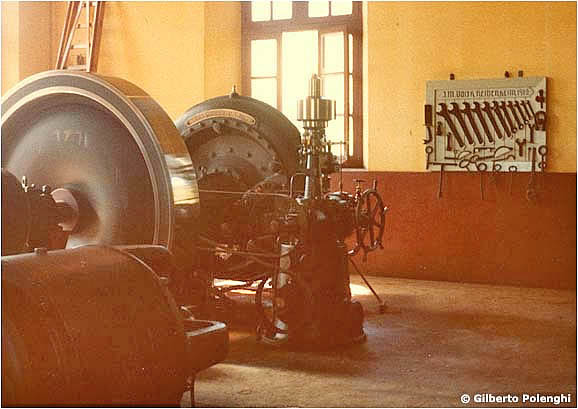
Also in 1912, Eduardo Guinle & Cia of Rio de Janeiro, agent for U.S. General Electric, ordered eight rail vehicles for Piraju from J. G. Brill Co. in Philadelphia: six 4-axle freight cars numbered 1-6, and two 4-axle passenger trams numbered 7 and 8. Here is a photograph taken at the Brill factory in 1912 of 12-bench passenger trailer 7, which was later motorized [Brill Collection, Historical Society of Pennsylvania]:
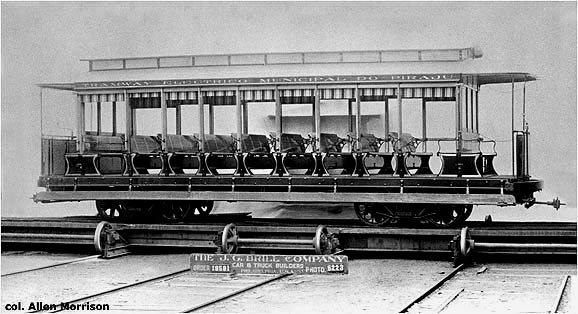
In 1913 Guinle acquired another 4-axle passenger tram from Brill, number 10, and a smaller 9-bench _2-axle_passenger car, numbered 9, from an unidentified source [see below]. Tramway Eléctrico Municipal do Piraju began testing on 1 August and was formally inaugurated on 15 August 1915. Track gauge was meter and the motor cars carried U.S.-style trolley poles. The line began at the railroad station [see city map], where the photograph below was taken on opening day [col. AM]:
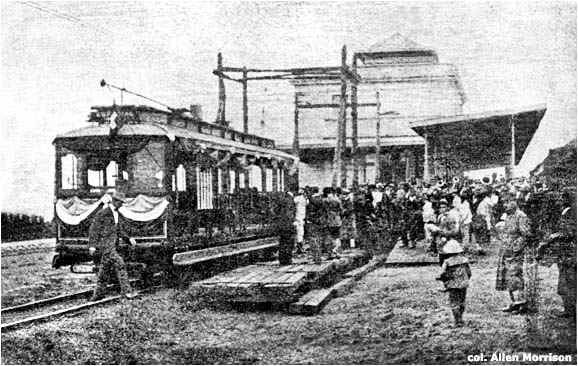
The tramway builders, local politicians and their families posed before boarding the tram for the inaugural ride [col. Gilberto Polenghi]:
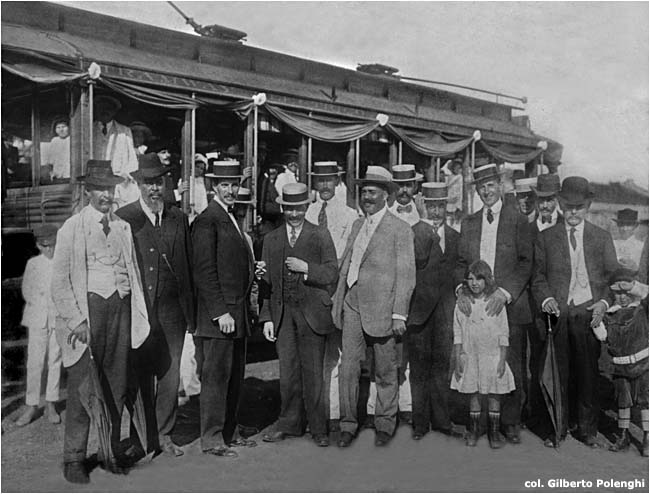
From Vila Tibiriçá the line wound down the hill on private right-of-way, crossed the Paranapanema River on a steel trestle and looped around Piraju streets. The interurban line left the urban line near the bridge [see city map]. The photograph below, taken about 1930, shows a happy group descending the hillside into the river valley. View is south. That's Piraju on the other side of the river [col. Gilberto Polenghi]:
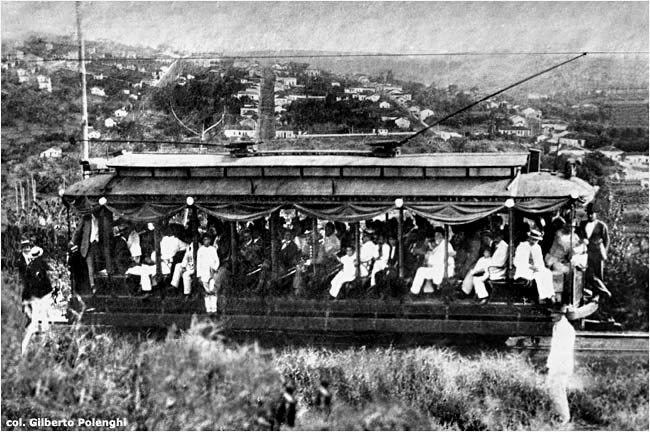
The bridge that the tramway used to cross the river was built by the Anglo-Brazilian Iron Company under the supervision of Kermit Roosevelt, son of U.S. President Theodore Roosevelt. Theodore visited his son in Piraju in October 1913 and both left the area soon after, long before the tramway opened. The photograph below, dated April 1914, shows the 109 m (358 ft) steel span under construction next to a wagon bridge. View is north, from the south bank of the river [see city map] [col. AM]:
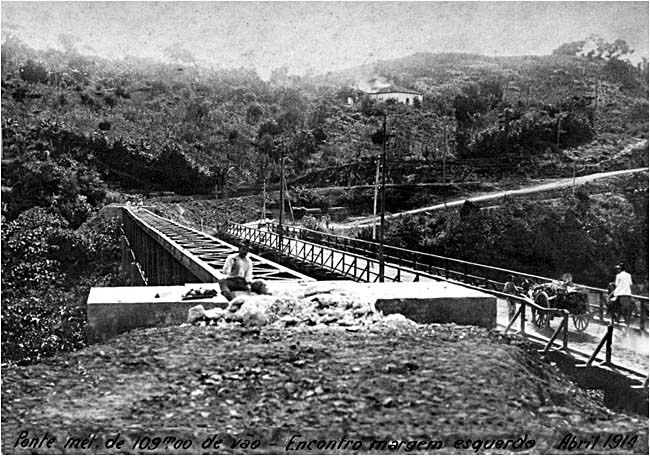
The undated picture below, looking in the same direction, shows a tram traveling south on what seems to be a wooden bridge next to the wagon bridge. This is, in fact, the same steel structure as above – supported by wooden beams [col.AM]:
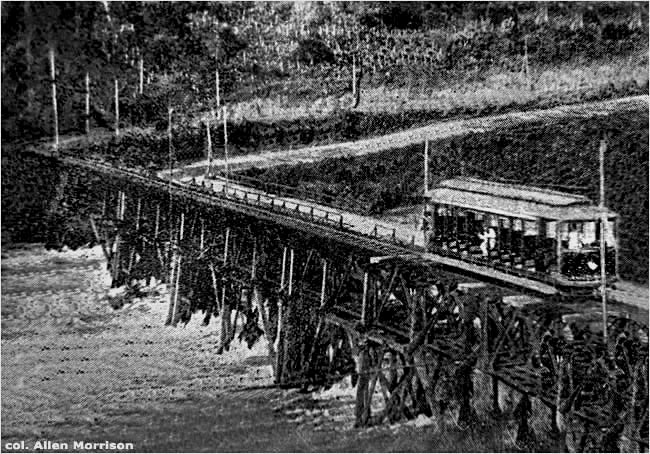
The tramway bridge was also used by pedestrians, animals and other vehicles, for there was no other way to cross the Paranapanema River [see city map]. Note overhead trolley wire [col. Gilberto Polenghi]:
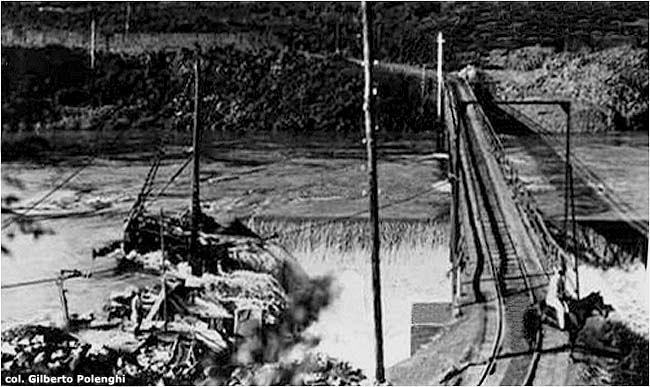
This photograph, taken in the 1930s, shows the dam that will eventually raise the level of the water that will submerge the tramway bridge in the distance [see city map]. It seems to have railway ties on top, which might have been intended for the tramway. Note the tram at A and the tram track alongside the road at B. At C it turned away from the road and ran toward Rua Major Mariano at D and the tram depot (not shown) at E [col. AM]:
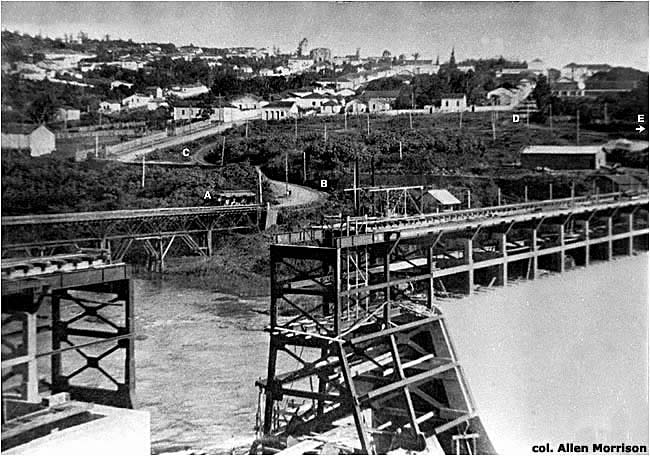
At the tram depot [see city map] the interurban line branched off the urban line and ran 26 km west and south to Sarutaiá [see area map]. Here is a rare postcard view of an unidentified 12-bench tram at Sarutaiá terminus. Date is 1916 [col. Irineu Selas Frias]:
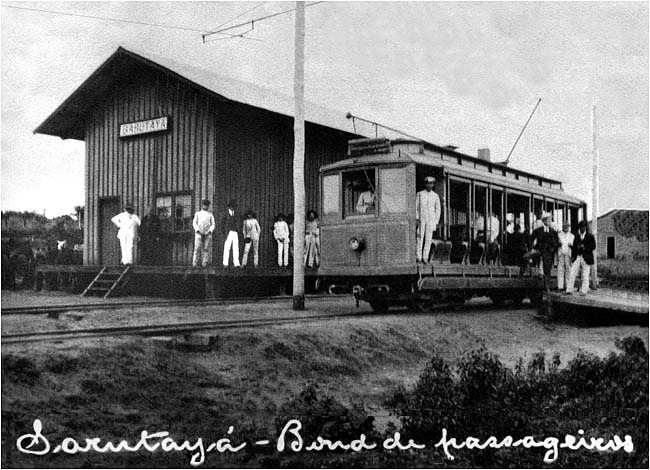
See a 1917 timetableof the "Saturayá" line of the Tramway Electrico Municipal de Pirajú [col. Antonio Carlos Belviso]. Part of a 1937 timetable is reproduced lower on this page.
Here is an enlargement of a second-class ticket used on the line. Dr. Rubião Junior had a farm about halfway to Sarutayá [col. Gilberto Polenghi]:
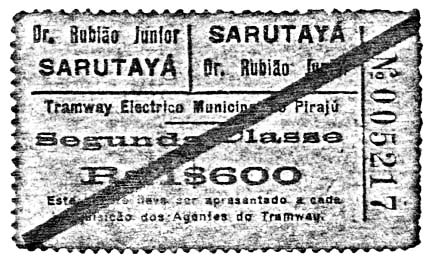
The origin of 4-wheel passenger tram 9, shown here on Rua Major Mariano [see city map], is mysterious. This is a classic Brill design, but there is no order for such a vehicle in Brill records. It seems likely that Tramway Elétrico Municipal de Piraju acquired the car from São Paulo Tramway, Light & Power Co., which supplied similar vehicles in 1914 to the tramway in Sorocaba, which also used meter gauge [col. AM]:
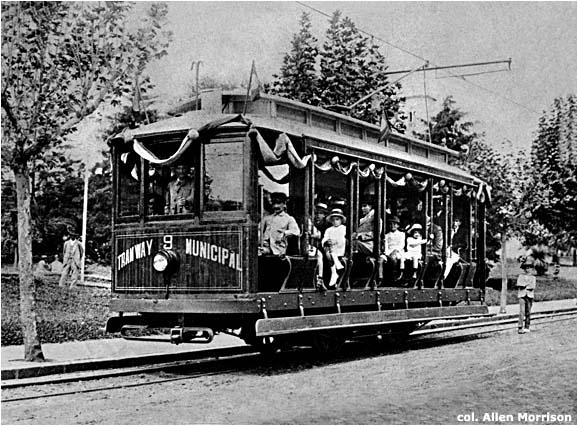
The electric tramway was obviously a source of pride and pleasure for the residents of the little town, but TEMP's principal business was agriculture. The photograph below, taken in Philadelphia, shows one of the motorized freight cars with 27GE1 trucks that TEMP ordered from Brill in 1912 [Brill Magazine, Philadelphia, 12/1913, p. 378]:
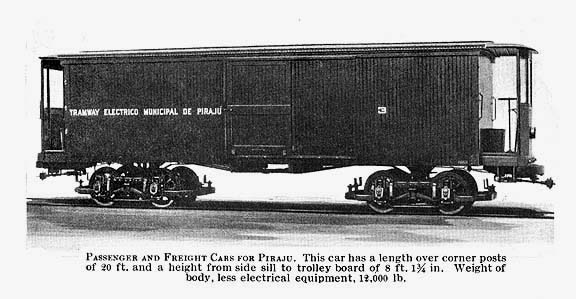
According to Brill records, car 2 was built in 1912 as a gondola trailer, with model 55F trucks. This undated photograph shows a motorized box car with Brill 27GE1 trucks, similar to car 3 above. Apparently many cars were reconstructed. The trail cars were rebuilt as motor cars [col. AM]:
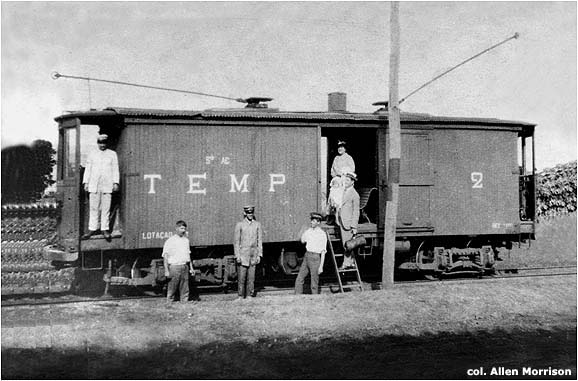
The Brill order books describe Piraju 6 as a trail car, with 55F trucks, for transporting livestock. Piraju 6 in this photograph is a motorized gondola, with 27GE1 trucks, that carried hay [col. Gilberto Polenghi]:
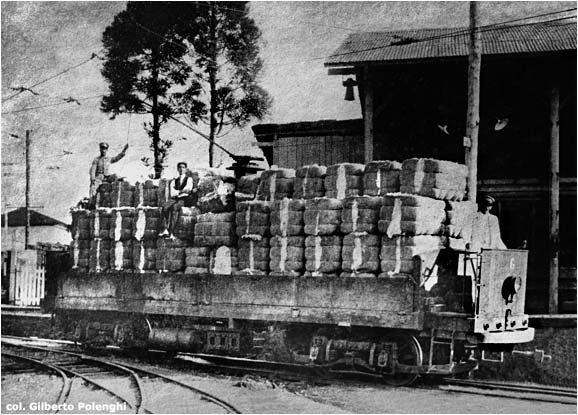
The _Anuário Estatístico_of the state of São Paulo reported that Tramway Eléctrico Municipal de Piraju operated six passenger cars and ten freight cars in 1916. The same survey reported seven passenger cars and eight freight cars in 1921. Brill built nine vehicles for Piraju. Another passenger car came presumably from São Paulo. The origin of the other six vehicles is unknown. Here is a motorized gondola numbered 5 at a tramway workers picnic in 1923. Location is Santa Virgínia farm, not far from the Boa Vista power plant shown in the first photograph [see area map]. Note that every man (and child) has a hat and the automobile is numbered 32 [col. Ernesto & Jaime Baptista]:
BIBLIOGRAPHY
(in order of publication)
Untitled news items in Brazil-Ferro-Carril (Rio de Janeiro), 6/1911, p. 8 and 31/8/1915, p. 338. Planning, construction and inauguration of the Piraju tramway.
"Passenger and Freight Cars for Piraju" in Brill Magazine (Philadelphia), 12/1913, pp. 377-379. Text, diagrams and photographs of Brill cars built for Piraju.
São Paulo (state). Repartição de Estatística e Archivo do Estado. _Anuário Estatístico de São Paulo,_1915-1921. São Paulo , 1916-1926. "Viação Urbana" section in vol. 2 each year provides statistics on Tramway Eléctrico Municipal de Piraju.
São Paulo (state). Instituto Geográfico e Geológico. "Piraju" topographic map, scale 1:100,000, 1919. The interurban tramway between Vila Tibiriçá and Sarutaiá.
_The Letters of Theodore Roosevelt._Elting E. Morison, editor. Cambridge, Massachusetts, 1954. A footnote on p. 752 of vol. 7 says: "Roosevelt, Mrs. Roosevelt and their niece, Margaret Roosevelt, sailed from New York for Rio de Janeiro on October 4 . . . On October 16 the whole party left Rio, going by train to São Paulo, Santos and Porto Alegre." The chronology in vol. 8, Appendix IV, p. 1482, states that Theodore "inspects industries including Anglo-Brazilian Iron Co." on October 28.
Leman, Constantino. Piraju, Ontem e Hoje. Piraju, 1959. Description of the tramway, pp. 120-122.
Polenghi, Gilberto. "Relembrando..." Folha de Piraju (Piraju), 4/2/1984, p. 6. Description of the Sarutaiá interurban line.
Piraju vai importar bondes paraguaios, Terra Networks article of 8/2/2001 about the tourist tramway project.
Ralph Mennucci Giesbrecht. Estações Ferroviárias do Brasil: Piraju. Description, history and photographs of the Piraju railroad station.
Estância Turística de Piraju. The Galeria de fotos antigas do município includes some interesting enlargeable views of the tramway bridge.
Olivier Vianna. O bonde elétrico de Piraju. Nice webpage by Piraju resident. Text and nine illustrations (one from this page).
The author wishes to express his special thanks to Piraju residents Gilberto Polenghi, Motaury Iaralham and Erwin Von Wromski for their contributions to this study.
Veja versão em português
See my index of
ELECTRIC TRANSPORT IN LATIN AMERICA
If you have comments, criticism or suggestions,
please e-mail me! Leio e escrevo português.
This site was placed online on
3 May 2007
Copyright © 2007-2107 Allen Morrison ALL RIGHTS RESERVED TODOS OS DIREITOS RESERVADOS